Reconstructing Ancient Iron-Smelting Furnaces of Guéra (Chad) Through 3D Modeling and AI-Assisted Video Generation
Abstract
1. Introduction
1.1. Research Context on Ancient Iron Metallurgy in Africa
1.2. Variability of Ironworking Techniques
1.3. Socio-Economic Role of Iron in Pre-Industrial African Societies
1.4. Persistence of Traditions and Combined Approaches
1.5. Research Gaps in Chad and Focus on the Guéra Region
1.6. Technological Context: AI, AR/VR, and 3D Reconstruction
1.7. Objectives and Positioning of the Study
2. Materials and Methods
2.1. Methodology of Oral Surveys
2.1.1. Individual Interviews
2.1.2. Collective Interviews
2.1.3. Summary of the Survey Campaigns
- 2016: Three villages in Dangléat territory were the subject of preliminary surveys, which led to the identification of three metallurgical sites.
- 2017: An extensive campaign made it possible to travel by motorcycle through about twenty localities spread over 138 km. Around forty people were interviewed to document the sites, the smelting techniques, and settlement dynamics.
- 2018: The surveys focused on identifying metallurgists, the status of blacksmiths, and the location of new sites. Thirty-seven people were interviewed in ten villages.
- 2019: The investigations aimed to clarify the identity of metallurgists at certain sites and to verify the existence of new sites in the studied area. Four villages were visited and about twenty people were interviewed.
2.2. The History of the Daradik
2.3. Reduction Among the Daradik
2.4. The History of the Filémat
2.5. Reduction Among the Filémat
2.6. Three-Dimensional Reconstruction
2.7. AI Reconstruction
A realistic photograph of a traditional iron-smelting furnace in full operation, reconstructed exactly according to this description. The furnace is 1 m tall, conical in shape, with a base diameter of 40 cm, built from reddish-brown mud. At its base, three small rounded tuyères (nozzle-like vents) emerge, oriented outward and slightly downward. Small, dense smoke rises from the top and some of the tuyères, while a red-orange glow is visible inside, showing active iron smelting. Three Chadian men from rural villages in the Guéra region work around the furnace: one is feeding wood or charcoal into a tuyère, while the other two supervise and tend the area. The setting is a dry savannah landscape with cracked soil, sparse vegetation, scattered rocks, and distant hills under bright daylight. Realistic lighting, dust, and subtle heat distortion should be visible.
Generate a short video showing three Black Chadian men in traditional attire around a 1-meter-high traditional Chadian charcoal furnace used for ironmaking, set in a dry, arid landscape. Two men are actively working at the furnace: one crouches and adjusts a piece of wood in a tuyère to keep the fire burning, while thick smoke rises from the conical clay or earth top. The third man stands nearby, observing. In the background, sparse vegetation and a few dry trees are visible under a clear, hot, desert-like sky. Capture the sense of traditional craftsmanship, teamwork, and rural life.
3. Results
3.1. Three-Dimensional Reconstruction of Traditional Furnaces
3.2. AI-Based Video Reconstructions
- (a)
- Archaeological fidelity: correspondence with field survey data and 2D plans (furnace shape, tuyère type and orientation, and actors’ positions).
- (b)
- Visual realism: texture quality, lighting, proportions, and material rendering.
- (c)
- Cultural authenticity: accuracy of clothing, skin tone, and actors’ postures.
- (d)
- Camera dynamics: stability or movement consistent with intended style (documentary or cinematic).
- (e)
- Environmental representation: credibility of background landscape and integration in the geographical context.
- (f)
- Atmospheric effects: smoke, flames, dust, and thermal distortion rendering.
- Sequence from ChatGPT-generated image (bottom row).
- Sequence from 3D Blender rendering (top row).
4. Discussion
4.1. Archaeological and Reconstruction Challenges
4.2. Technological and Scientific Contributions
- The direct linkage between in situ ethnographic data and digital reconstructions, ensuring a strong scientific grounding;
- The innovative use of natural language prompts to generate both images and videos, opening the way to dynamic and contextualized visual storytelling [65];
- The implementation of a standardized evaluation framework to assess archaeological fidelity, cultural authenticity, and visual quality, thus limiting the risk of interpretive drift or excessive “embellishment”.
4.3. Methodological Limitations
4.4. Ethical and Cultural Implications
- Cultural biases embedded in training datasets may reproduce stereotypical representations, distorting the image of the societies under study.
- The visual realism of AI-generated images may create an illusion of authenticity, potentially misleading both researchers and the public if uncertainties are not explicitly communicated.
- The involvement of local communities in validating reconstructions is essential to ensure respect, legitimacy, and scientific reliability.
4.5. Immersive Applications and Future Perspectives
- Immersive training for researchers, students, and artisans;
- Participatory digital museology initiatives;
- The virtual preservation of technical know-how at risk of disappearing.
5. Conclusions
Author Contributions
Funding
Institutional Review Board Statement
Informed Consent Statement
Data Availability Statement
Conflicts of Interest
References
- Quéchon, G. Les datations de la métallurgie du fer à Termit (Niger): Leur fiabilité, leur signification. Mediterr. Archaeol. 2001, 14, 247–253. [Google Scholar]
- Bocoum, H. Aux origines de la métallurgie du fer en Afrique de l’Ouest. Mediterr. Archaeol. 2001, 14, 235–245. [Google Scholar]
- Essomba, J.M. Bilan de l’archéologie de l’âge de fer au Cameroun Méridional; UNESCO Headquarters: Paris, France, 2002. [Google Scholar]
- Killick, D. What do we know about African iron working? J. Afr. Archaeol. 2004, 2, 97–112. [Google Scholar] [CrossRef]
- Alpern, S.B. Did they or didn’t they invent it? Iron in sub-Saharan Africa. Hist. Afr. 2005, 32, 41–94. [Google Scholar] [CrossRef]
- Chirikure, S.; Rehren, T. Ores, furnaces, slags, and prehistoric societies: Aspects of iron working in the Nyanga Agricultural Complex, AD 1300–1900. Afr. Archaeol. Rev. 2004, 21, 135–152. [Google Scholar] [CrossRef]
- Chirikure, S.; Burrett, R.; Heimann, R.B. Beyond furnaces and slags: A review study of bellows and their role in indigenous African metallurgical processes. Azania Archaeol. Res. Afr. 2009, 44, 195–215. [Google Scholar] [CrossRef]
- Chirikure, S. Metals in society: Iron production and its position in Iron Age communities of southern Africa. J. Soc. Archaeol. 2007, 7, 72–100. [Google Scholar] [CrossRef]
- Robion-Brunner, C. L’Afrique des métaux. In L’Afrique Ancienne. De l’Acacus au Zimbabwe, 20000 Avant Notre ère–XVIIe Siècle; Fauvelle, F.X., Ed.; Belin: Paris, France, 2018; pp. 518–543. [Google Scholar]
- Célis, G. Les Fonderies Africaines du fer, un Grand Métier Disparu; Frankfurt, Museum für Völkerkunde: Frankfurt am Main, Germany, 1991. [Google Scholar]
- Martinelli, B. Au seuil de la métallurgie intensive–Le choix de la combustion lente dans la boucle du Niger (Burkina Faso et Mali). In Aux Origines de la Métallurgie du fer en Afrique—Une Ancienneté Méconnue; Bocoum, H., Ed.; Éditions de l’UNESCO: Paris, France, 2002; pp. 165–188. [Google Scholar]
- Robion-Brunner, C.; Serneels, V.; Perret, S. Variability in iron smelting practices: Assessment of technical, cultural and economic criteria to explain the metallurgical diversity in the Dogon area (Mali). In The World of Iron; Archetype Publications London: London, UK, 2013; pp. 257–265. [Google Scholar]
- Serneels, V.; Kiénon-Kaboré, H.T.; Koté, L.; Kouassi, S.K.; Ramseyer, D.; Simporé, L. Origine et développement de la métallurgie du fer au Burkina Faso et en Côte d’Ivoire. Premiers résultats sur le site sidérurgique de Korsimoro (Sanmatenga, Burkina Faso). In Jahresberichtder Schweizerisch-Liechtensteinische Stiftung für Archäologische Forschungen im Ausland (SLSA); Thorbecke Verlag: Zürich, Switzerland, 2012; pp. 23–54. [Google Scholar]
- Serneels, V.; Donadini, F.; Kiénon-Kaboré, H.T.; Koté, L.; Kouassi, S.K.; Ramseyer, D.; Simporé, L. Origine et développement de la métallurgie du fer au Burkina Faso et en Côte d’Ivoire. Avancement des recherches en 2013 et quantification des vestiges de Korsimoro (Burkina Faso). In Jahresbericht der Schweizerisch-Liechtensteinische Stiftung für Archäologische Forschungen im Ausland SLSA; Thorbecke Verlag: Zürich, Switzerland, 2014; pp. 65–112. [Google Scholar]
- Robion-Brunner, C. Peuplements des Forgerons et Traditions Sidérurgiques: Vers une Histoire de la Production du fer sur le Plateau de Bandiagara (Pays Dogon, Mali) Durant les Empires Précoloniaux; Journal of African Archaeology Monograph Series; Africa Magna Verlag: Frankfurt, Germany, 2010; Volume 3, Série Monographique 1. [Google Scholar]
- Kiéthéga, J.B. La Métallurgie Lourde du fer au Burkina Faso: Une Technologie à L’époque Précoloniale; Karthala Éditions: Paris, France, 2009. [Google Scholar]
- Fabre, J.M. La métallurgie du fer au Sahel burkinabé à la fin du 1 millénaire AD. In Crossroads/Carrefour Sahel: Cultural and Technological Developments in First Millennium BC/AD West Africa; Africa Magna Verlag: Main, Germany, 2009; p. 167. [Google Scholar]
- Guillon, R.; Petit, C.; Rajot, J.L.; Bichet, V.; Idé, O.A.; Garba, Z.; Sebag, D.; Touré, A.A. Analyse de la répartition spatiale de bas fourneaux d’un territoire sidérurgique au sud-ouest du Niger (4e-14e siècle ap. J.-C.). In Métallurgie du fer et Sociétés Africaines: Bilans et Nouveaux Paradigmes dans la Recherche Anthropologique et Archéologique; HAL: Lyon, France, 2012; pp. 153–163. [Google Scholar]
- Robion-Brunner, C. «Pourquoi ton four n’est pas comme le mien?» Diversité technique dans la sidérurgie ancienne: Le cas du Dendi (Bénin). J. Afr. 2018, 88, 16–39. [Google Scholar] [CrossRef]
- Robion-Brunner, C. What Is the Meaning of the Extreme Variability of Ancient Ironworking in West Africa? A Comparison between Four Case Studies; Cambridge University Press: Cambridge, UK, 2020; pp. 290–314. [Google Scholar] [CrossRef]
- Serneels, V. Des montagnes de fer en pays dogon. In Le Magazine de l’Université de Fribourg; Université de Fribourg: Fribourg, Switzerland, 2009; pp. 44–45. [Google Scholar]
- Martinelli, B. Le choix de la combustion lente. Mutation technique et mutation sociale au Yatenga, Burkina Faso. In Arts du feu et Productions Artisanales; HAL: Lyon, France, 2000; pp. 123–142. [Google Scholar]
- Muramira, F. Mutation de la Technologie du fer en Centre Afrique: Étude Comparée de la Forge en Bangui-Bambari. Master’s Thesis, Faculté des Lettres, Arts et Sciences Humaines, Université de Bangui, Bangui, Central African Republic, 2006. [Google Scholar]
- Courtin, J. Découverte de harpons en os au Borkou, République du Tchad. In Bulletin de la Société Préhistorique Française. Comptes Rendus des Séances Mensuelles; Société Préhistorique Française: Paris, France, 1965; pp. LXX–LXXV. [Google Scholar] [CrossRef]
- Courtin, J. Poterie à décor zoomorphe du Nord-Tchad, environs de Largeau, Borkou. In Bulletin de la Société Préhistorique Française. Comptes Rendus des Séances Mensuelles; Société Préhistorique Française: Paris, France, 1965; pp. CXXXV–CXXXVIII. [Google Scholar] [CrossRef]
- Courtin, J. Labrets préhistoriques en quartz au Borkou, Nord-Tchad. In Bulletin de la Société Préhistorique Française. Comptes Rendus des Séances Mensuelles; Société Préhistorique Française: Paris, France, 1965; pp. CXLVIII–CLI. [Google Scholar] [CrossRef]
- Treinen-Claustre, F. Sahara et Sahel à l’âge du fer: Borkou, Tchad; Société des Africanistes: Paris, France, 1982; Volume 7. [Google Scholar]
- Lavachery, P.; MacEachern, S.; Bouimon, T.; Gouem Gouem, B.; Kinyock, P.; Mbairo, J.; Mbida, C.; Nkokonda, O. Cultural heritage management in Central Africa: Regional survey on the Chad-Cameroon oil pipeline. Antiquity 2005, 79, 56–60. [Google Scholar]
- Lavachery, P. De Komé à Kribi: Archéologie Préventive le Long de l’oléoduc Tchad-Cameroun, 1999–2004; Africa Magna: Frankfurt am Main, Germany, 2010. [Google Scholar]
- Mbairo, J. Sites Métallurgiques de Maikery dans le Canton Miandoum: Archéologie et Traditions Orales. Master’s Thesis, Université de Paris I Panthéon-Sorbonne, Paris, France, 2007. [Google Scholar]
- Mbairo, J. Répertoire des Sites Culturels du Bassin Pétrolier, Rapport Annuel (Doba, Logone Oriental); Rapport Annuel; HAL Open Science: Lyon, France, 2011. [Google Scholar]
- Clison, N. Paléométallurgie du fer à Kana et à Deli et Mouvements de Populations Dans la Haute Vallée du Logone au Sud du Tchad. Ph.D. Thesis, Département d’Histoire et d’Archéologie, Université de Ouagadougou, Ouagadougou, Burkina Faso, 2015. [Google Scholar]
- Dérendinger, G. Les curieuses mines de fer de Télé-Nugar (Tchad). J. Soc. Afr. 1936, 6, 197–204. [Google Scholar] [CrossRef]
- Guemona, D. La Paléo-Métallurgie dans la région du Guéra (Centre du Tchad): Inventaire des Sites et Essai de Caractérisation des Traditions Sidérurgiques. Ph.D. Thesis, Université Toulouse le Mirail-Toulouse II, Toulouse, France, 2020. [Google Scholar]
- Kersten, T.; Tschirschwitz, F.; Deggim, S. Virtual and Augmented Reality Applications in Cultural Heritage. Remote Sens. 2023, 15, 542. [Google Scholar] [CrossRef]
- Piccirillo, A.; Buscaglia, P.; Caliri, C.; Romano, F.P.; Pavone, D.P.; Ravan, E.L.; Botticelli, M.; Conti, C.; Catrambone, M.; Miliani, C.; et al. Unraveling the mummy’s shroud: A multi-analytical study of a rare painted textile from Roman Egypt. J. Cult. Herit. 2024, 68, 107–121. [Google Scholar] [CrossRef]
- Bekele, M.; Pierdicca, R.; Frontoni, E.; Malinverni, E.S.; Gain, J. A Survey of Augmented, Virtual, and Mixed Reality for Cultural Heritage. J. Comput. Cult. Herit. 2018, 11, 1–36. [Google Scholar] [CrossRef]
- Bruno, F.; Bruno, S.; De Napoli, L. Immersive Virtual Museums: State of the Art and Future Trends. Appl. Sci. 2023, 13, 8134. [Google Scholar] [CrossRef]
- Mildenhall, B.; Srinivasan, P.P.; Tancik, M.; Barron, J.T.; Ramamoorthi, R.; Ng, R. NeRF: Representing Scenes as Neural Radiance Fields for View Synthesis. Commun. ACM 2021, 65, 99–106. [Google Scholar] [CrossRef]
- Zarzo, M. Clarifying Key Concerns about the Dating of Holy Relics: The Holy Chalice of the Last Supper at the Cathedral of Valencia. Heritage 2024, 7, 139–161. [Google Scholar] [CrossRef]
- Kerbl, B.; Kopanas, G.; Leimkühler, T.; Drettakis, G. 3D Gaussian Splatting for Real-Time Radiance Field Rendering. In Proceedings of the ACM SIGGRAPH 2023 Conference Proceedings, Los Angeles, CA, USA, 6–10 August 2023. [Google Scholar] [CrossRef]
- Forte, M. Exploring Multiverses: Generative AI and Neuroaesthetic Perspectives. Heritage 2025, 8, 102. [Google Scholar] [CrossRef]
- Alhassane, M.; Barreau, J.B.; Varoutsikos, B.; Cissée, A.; Coulin, M.; Ubelmann, Y.; Salifou, A.; Giligny, F. Digital Preservation and Restoration of Historic Buildings in Agadez, Niger. In 3D Research Challenges in Cultural Heritage IV; Springer Nature: Cham, Switzerland, 2025; pp. 97–109. [Google Scholar] [CrossRef]
- Boswell, R. Review: Zamani Project. Rev. Digit. Humanit. 2024, V. [Google Scholar] [CrossRef]
- Rüther, H.; Held, C.; Bhurtha, R.; Schröder, R.; Wessels, S. Challenges in heritage documentation with terrestrial laser scanning. In Proceedings of the 1st AfricaGEO Conference, Capetown, South Africa, 31 May–1 June 2011; Volume 30. [Google Scholar]
- Yaseen, F.R.; Mustafa, F.A.; Rashid, S.J. Study of the Minaret Location in the Context of Main Styles of Mosques: A Geometric-Thematic Analysis. Eurasian J. Sci. Eng. 2023, 9, 180–200. [Google Scholar] [CrossRef]
- Franczuk, J. Information processes in Virtual 3D reconstruction of Roman Three-Bay Double Arch of Musti (Tunisia). Virtual Archaeol. Rev. 2025, 16, 1–16. [Google Scholar] [CrossRef]
- Ben Charif, H.; Zerlenga, O.; Iaderosa, R. Low-Cost Photogrammetry for Detailed Documentation and Condition Assessment of Earthen Architectural Heritage: The Ex-Hotel Oasis Rouge in Timimoun as a Case Study. Buildings 2024, 14, 3292. [Google Scholar] [CrossRef]
- Ye, S.; Wu, T.; Jarvis, M.; Zhu, Y. Digital reconstruction of Elmina Castle for mobile virtual reality via point-based detail transfer. Electron. Imaging 2022, 34, 409-1–409-8. [Google Scholar] [CrossRef]
- Robion-Brunner, C.; Serneels, V. Protéger et fouiller un site archéologique: Le cas des sites métallurgiques. In Manuel de Terrain en Archéologie Africaine; Musée Royal de l’Afrique Centrale: Tervuren, Belgium, 2017; pp. 129–133. [Google Scholar]
- Diop, P.S. Introduction à l’oeuvre littéraire de Boubacar Boris Diop: Du français au wolof. Études Littéraires Afr. 2018, 19–29. [Google Scholar] [CrossRef]
- Saxon, D.E. Wadai (Ouaddai) Empire. In The Encyclopedia of Empire; Wiley: Hoboken, NJ, USA, 2016; pp. 1–2. [Google Scholar] [CrossRef]
- Akaaimo, D.; Raji, A. Some physical and engineering properties of Prosopis africana seed. Biosyst. Eng. 2006, 95, 197–205. [Google Scholar] [CrossRef]
- Bargali, K.; Bargali, S. Acacia nilotica: A multipurpose leguminous plant. Nat. Sci. 2009, 7, 11–19. [Google Scholar]
- Barreau, J.B.; Nouviale, F.; Gaugne, R.; Bernard, Y.; Llinares, S.; Gouranton, V. An Immersive Virtual Sailing on the 18th-Century Ship Le Boullongne. Presence Teleoperators Virtual Environ. 2015, 24, 201–219. [Google Scholar] [CrossRef]
- Blain, J.M. The Complete Guide to Blender Graphics: Computer Modeling & Animation; AK Peters/CRC Press: Boca Raton, FL, USA, 2019. [Google Scholar]
- Hamdani, A. 3D Environment Design with Blender: Enhance Your Modeling, Texturing, and Lighting Skills to Create Realistic 3D Scenes; Packt Publishing Ltd.: Birmingham, UK, 2023. [Google Scholar]
- Rao, G.R.K.; Sgar, P.V.; Bikku, T.; Prasad, C.; Cherukuri, N. Comparing 3D rendering engines in blender. In Proceedings of the 2021 2nd International Conference on Smart Electronics and Communication (ICOSEC), Trichy, India, 7–9 October 2021; pp. 489–495. [Google Scholar] [CrossRef]
- Cobb, P.J. Large language models and generative ai, oh my!: Archaeology in the time of chatgpt, midjourney, and beyond. Adv. Archaeol. Pract. 2023, 11, 363–369. [Google Scholar] [CrossRef]
- Gheorghiu, D.; Ştefan, L.; Moţăianu, M.; Olteanu, V. Augmented Creativity: Augmenting the Archaeological Imagination with Generative AI Tools. In Human-Computer Creativity; Springer Nature: Cham, Switzerland, 2025; pp. 217–240. [Google Scholar] [CrossRef]
- Wan, T.; Wang, A.; Ai, B.; Wen, B.; Mao, C.; Xie, C.W.; Chen, D.; Yu, F.; Zhao, H.; Yang, J.; et al. Wan: Open and Advanced Large-Scale Video Generative Models. arXiv 2025, arXiv:2503.20314. [Google Scholar] [CrossRef]
- Barreau, J.B. Reconstructing Ancient Iron Smelting Furnaces of Guéra (Chad) Through 3D Modeling and AI-Assisted Video Generation [3D Model]. 2025. Available online: https://github.com/jean-baptiste-barreau/jean-baptiste-barreau.github.io/raw/refs/heads/main/publications/Reconstructing_Ancient_Iron_Smelting_Furnaces_of_Guera_(Chad)_through_3D_Modeling_and_AI_Assisted_Video_Generation/3D_model/Furnaces_of_Guera_(Chad).fbx (accessed on 20 September 2025).
- Barreau, J.B. Reconstructing Ancient Iron Smelting Furnaces of Guéra (Chad) Through 3D Modeling and AI-Assisted Video Generation [Video]. 2025. Available online: https://github.com/jean-baptiste-barreau/jean-baptiste-barreau.github.io/raw/refs/heads/main/publications/Reconstructing_Ancient_Iron_Smelting_Furnaces_of_Guera_(Chad)_through_3D_Modeling_and_AI_Assisted_Video_Generation/video_result.mp4 (accessed on 20 September 2025).
- Remondino, F. Heritage recording and 3D modeling with photogrammetry and 3D scanning. Remote Sens. 2011, 3, 1104–1138. [Google Scholar] [CrossRef]
- Guerreiro, J. Text-to-video generation for cultural heritage applications. In Proceedings of the 2023 IEEE International Symposium on Mixed and Augmented Reality (ISMAR), Sydney, Australia, 16–20 October 2023; pp. 784–793. [Google Scholar]
- Anwar, M.S.; Yang, J.; Frnda, J.; Choi, A.; Baghaei, N.; Ali, M. Metaverse and XR for cultural heritage education: Applications, standards, architecture, and technological insights for enhanced immersive experience. Virtual Real. 2025, 29, 51. [Google Scholar] [CrossRef]
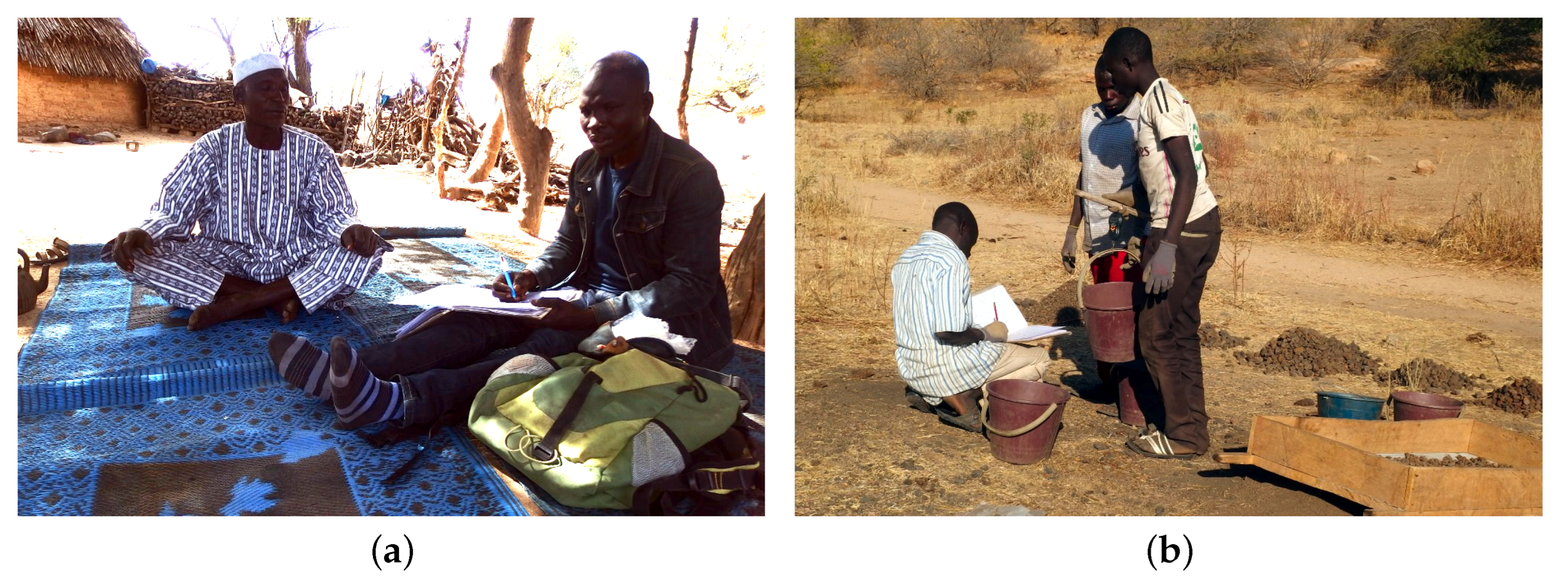
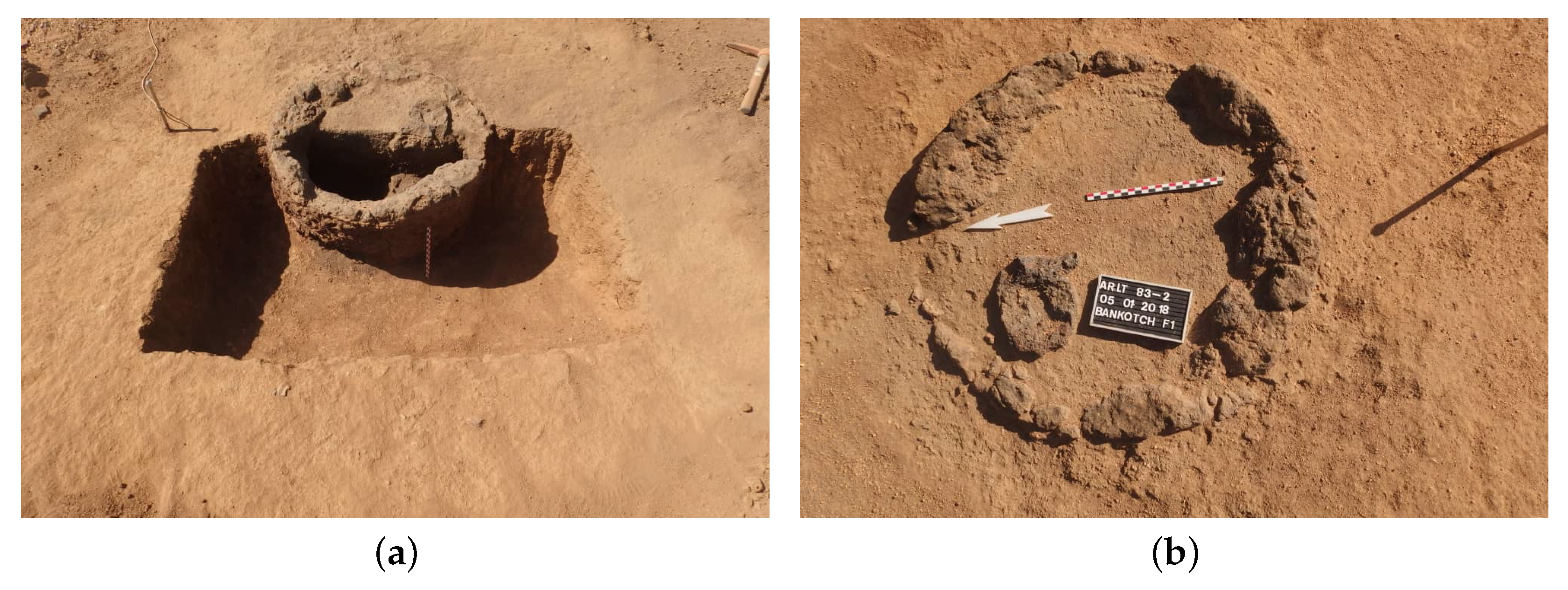
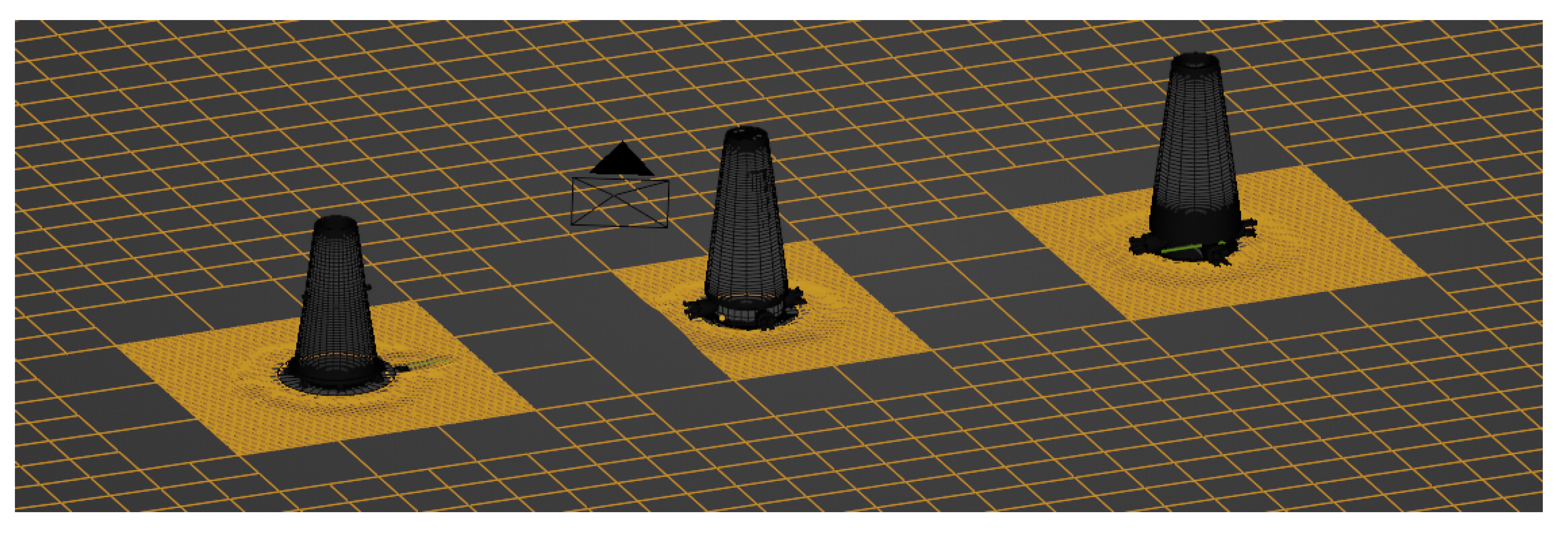
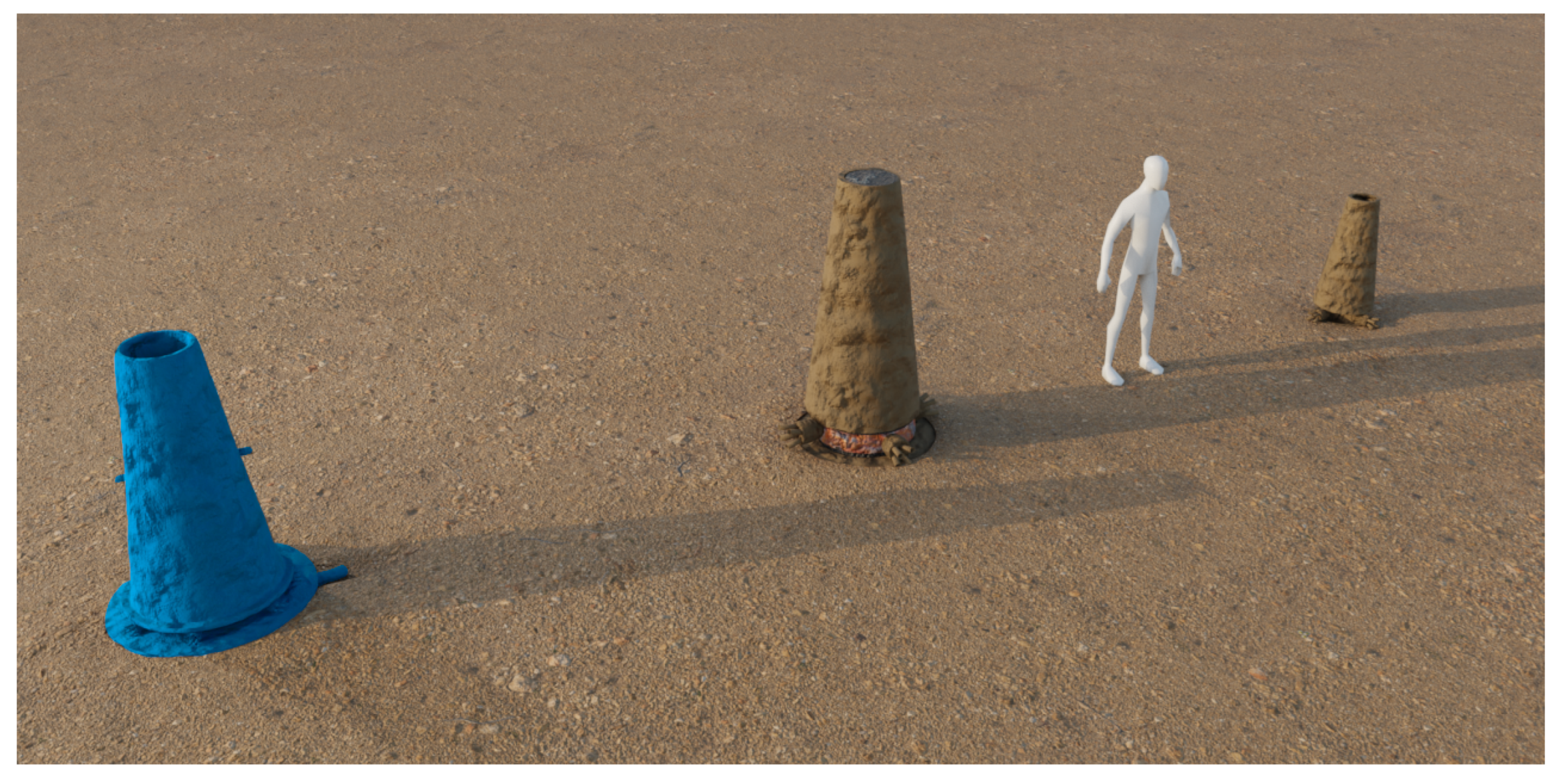
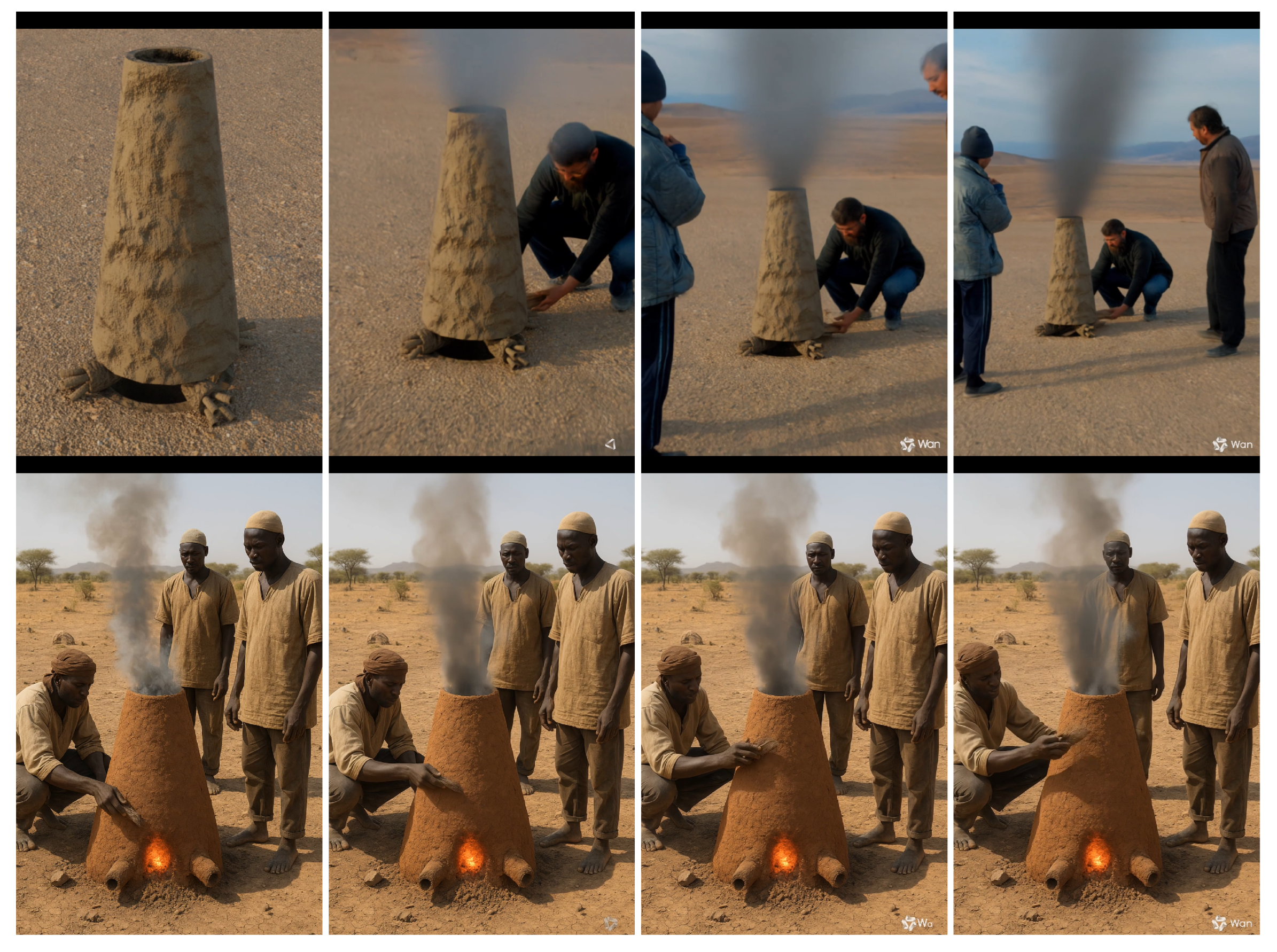
| Sequence Source | Fidelity | Realism | Authenticity | Camera | Environment | Effects |
|---|---|---|---|---|---|---|
| ChatGPT image | 3 | 4 | 4 | 5 | 4 | 3 |
| 3D Blender rendering | 4 | 3 | 2 | 4 | 4 | 4 |
Disclaimer/Publisher’s Note: The statements, opinions and data contained in all publications are solely those of the individual author(s) and contributor(s) and not of MDPI and/or the editor(s). MDPI and/or the editor(s) disclaim responsibility for any injury to people or property resulting from any ideas, methods, instructions or products referred to in the content. |
© 2025 by the authors. Licensee MDPI, Basel, Switzerland. This article is an open access article distributed under the terms and conditions of the Creative Commons Attribution (CC BY) license (https://creativecommons.org/licenses/by/4.0/).
Share and Cite
Barreau, J.-B.; Guemona, D.; Robion-Brunner, C. Reconstructing Ancient Iron-Smelting Furnaces of Guéra (Chad) Through 3D Modeling and AI-Assisted Video Generation. Electronics 2025, 14, 3923. https://doi.org/10.3390/electronics14193923
Barreau J-B, Guemona D, Robion-Brunner C. Reconstructing Ancient Iron-Smelting Furnaces of Guéra (Chad) Through 3D Modeling and AI-Assisted Video Generation. Electronics. 2025; 14(19):3923. https://doi.org/10.3390/electronics14193923
Chicago/Turabian StyleBarreau, Jean-Baptiste, Djimet Guemona, and Caroline Robion-Brunner. 2025. "Reconstructing Ancient Iron-Smelting Furnaces of Guéra (Chad) Through 3D Modeling and AI-Assisted Video Generation" Electronics 14, no. 19: 3923. https://doi.org/10.3390/electronics14193923
APA StyleBarreau, J.-B., Guemona, D., & Robion-Brunner, C. (2025). Reconstructing Ancient Iron-Smelting Furnaces of Guéra (Chad) Through 3D Modeling and AI-Assisted Video Generation. Electronics, 14(19), 3923. https://doi.org/10.3390/electronics14193923






